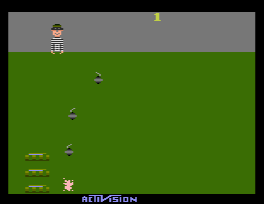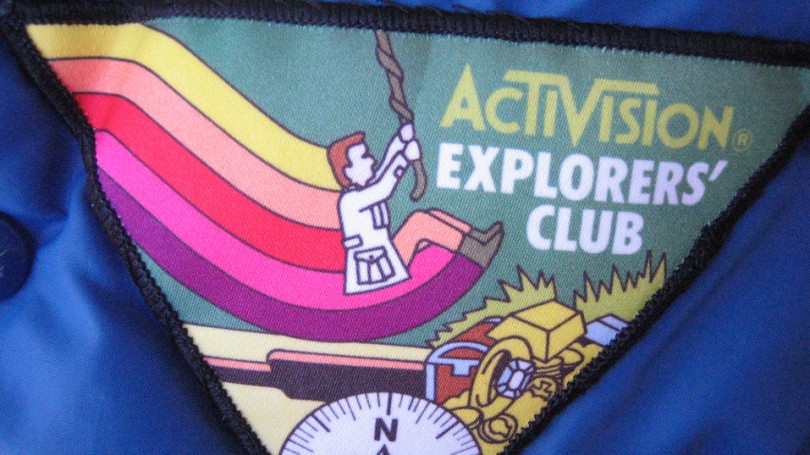aNewDomain — Anybody remember “Kaboom!?” This 1981 offering for the Atari 2600 was an inspired classic. Offering unique paddle control and a gameplay style similar to the popular arcade game “Arkanoid,” this innocent precursor to modern bomb security was a favorite in my house and many others around the country.
 “Kaboom!” sold over 1 million copies within two years of its release. It was one of a number of high-profile games sold by Activision, a company that’s done well for itself over the last three decades. From its offices in Santa Monica, Calif., Activision, which has gobbled up other game companies like Blizzard, Sandbox Arts and Sierra, continues to churn out award-winning entertainment and dominate parts of the video gaming world.
“Kaboom!” sold over 1 million copies within two years of its release. It was one of a number of high-profile games sold by Activision, a company that’s done well for itself over the last three decades. From its offices in Santa Monica, Calif., Activision, which has gobbled up other game companies like Blizzard, Sandbox Arts and Sierra, continues to churn out award-winning entertainment and dominate parts of the video gaming world.
That’s no small feat. The explosive advancement in technology we’ve seen since the late ’70s has grounded gigantic corporations like Blockbuster, Circuit City and Atari. Atari is the company that made the original gaming console for many Activision games. These other corporations fell, but the same challenges haven’t slowed Activision down even a little bit.
Why? Well, the company has an extremely interesting and impressive history, which is a large part of the reason.
Working Man’s Revenge
Part of the unique legacy of Activision is something any beer-swilling labor man can love. It’s a story of getting back at your boss by leaving and starting your own firm that, in time, leaves his in the dust. Activision’s rise also represents a move to untether gaming console makers from game developers, breaking apart the monopolistic combination that was, before the foundation of Activision, Atari’s domain.
 Historic accounts of the Activision story show that a number of Atari programmers started the firm back in 1979. They were fed up with the lack of appreciation and respect they received for being programmers of these wildly popular games. After meeting with Atari CEO Ray Kassar to lay their demands on the table, which included royalties for games and credits on game boxes, programmers David Crane, Larry Kaplan, Alan Miller and Bob Whitehead hoped for a smart concession and support. But the group didn’t get very far, and they left to set up their own company, sparking a barrage of legal activity and shaking up the industry, which changed video gaming destiny forever.
Historic accounts of the Activision story show that a number of Atari programmers started the firm back in 1979. They were fed up with the lack of appreciation and respect they received for being programmers of these wildly popular games. After meeting with Atari CEO Ray Kassar to lay their demands on the table, which included royalties for games and credits on game boxes, programmers David Crane, Larry Kaplan, Alan Miller and Bob Whitehead hoped for a smart concession and support. But the group didn’t get very far, and they left to set up their own company, sparking a barrage of legal activity and shaking up the industry, which changed video gaming destiny forever.
As Atari continued to claw for a foothold, Activision expanded and took on new projects, eventually making games for newer systems like Nintendo and Sega, both of which eclipsed Atari in the 1980s.
The rest of the company’s history is out there on the Internet and reads like a laundry list of successes, such as acquiring technology resources and producing new games and software. There’s also a legend that surrounds the story, including the controversial “Yar’s Revenge” video game, and other fierce competition between Atari and Activision.
What Happened to Atari?
Not too long after the departure of much of Atari’s head talent, the company got blindsided by what experts refer to as the “video game crash of 1983.” Atari’s successful production of early games like “Pong,” and associated gaming hardware, failed to insulate the company from a huge recession in gaming sales that ended up killing a lot of new projects in the cradle.
 There were a number of factors that led to the industry crash and then hiatus, which took place from 1983 to 1985, to be revived by the new Nintendo Entertainment System. One factor was the large number of game consoles available, each with its own proprietary set of game pack cartridges (remember the “Bally Astrocade?”).
There were a number of factors that led to the industry crash and then hiatus, which took place from 1983 to 1985, to be revived by the new Nintendo Entertainment System. One factor was the large number of game consoles available, each with its own proprietary set of game pack cartridges (remember the “Bally Astrocade?”).
But another major factor, according to many of those who documented the industry crisis, was the production of “weak” games — hastily produced and sometimes poorly thought out offerings that just didn’t engage players. For those who grew up with these games, this suggestion asks the question: What makes a good Atari game?
There were obviously severe limitations to the graphics potential for these early games, but not for the creative use of the platform to deliver interesting conceptual games. Much of Atari’s success involved simple action games like “Pac-Man,” or branded games like “E.T.” Despite outliers like Atari 2600’s “Raiders of the Lost Ark” Indiana Jones game (a compelling standout with a succession of adventure-oriented challenges), there was very little effort to create the kinds of broad storylines, large mappable worlds and developed characters found in the intense role-playing games that emerged with Nintendo just a few years later. Could this kind of development have saved Atari?
Another nail in Atari’s coffin was its proliferation of new consoles. When the incompatible Atari 5200 and Atari 7800 consoles came out on top of the popular 2600, it was game over for the company.
Retro video game enthusiasts would also point out that, unlike Atari, Commodore did pretty well through the video game recession, partly because its video game console was a hybrid version of an early personal computer. As Atari ended up burying much of its massive inventory in the desert, Commodore and Activision made it through.
What’s New from Activision?
Besides a range of this generation’s most popular games, including “Call of Duty,” “World of Warcraft” and even a brand-new edition of the video game “Walking Dead,” there’s now “Geometry Wars” in the works. It’s an interesting new game that takes some of the 1970s-era ideas about action characters to a unique place. Also “Call of Duty: Black Ops 3” is scheduled for a November 2015 release, just in time for holiday shopping.
“Geometry Wars” looks like “Pac-Man” on steroids, or “Asteroids” made into a dazzling, almost-bewildering set of virtual reality axes and 3D shapes. Packing tons of small icon pieces into an enormously sophisticated 3D model, it’s uniquely evocative because you can see so many aspects of now-ancient home and arcade classics, like “Galaga” and “Space Invaders,” in a highly evolved multiplayer format.
Video: Geometry Wars 3: Dimensions
Finding information about these new developments may require wading through fact sheets and media kits of new games. My efforts led me to the support page that required login for personal service. Another means of finding out company news is the series of press releases archived on an Activision-Blizzard page. But a quick perusal of YouTube and media reports can get you up to speed on what tomorrow’s game play will look like.
We’ve come a long way from those early gaming consoles and the days when the brightest stars in the video game world had to scrap for attention. Nowadays, mammoths like Activision and competitor Entertainment Arts are big California companies engaged in a brave new playground, with a big audience and huge creative sales potential. It will be interesting to see whether Activision, a company that rebuilt and adapted itself for the 21st century, will be doing even more in 2050.
For aNewDomain, I’m Justin Stoltzfus.
Images in order: Activision Explorers Club by m anima via Flickr; Kaboom! Wikimedia Commons; 1982 Activision by Axel Tregoning via Flickr; Atari 2600 by moparx via Flickr













